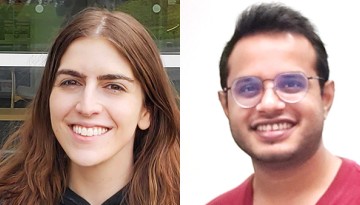Cornell University’s Fleming Research Fellows Dive into Understanding Heart Disease Drivers and Organ Shape Determinants
Postdoctoral researchers Julie Heffler and Avilash Singh Yadav have been awarded the 2023 Sam and Nancy Fleming Research Fellowships by the Weill Institute for Cell and Molecular Biology at Cornell University. These prestigious three-year fellowships support talented young researchers who are doing cutting-edge research in basic biomedical sciences and are planning careers in biological or medical research.
“The Fleming Fellowships provide exceptional young scientists the support and freedom to pursue ambitious projects,” said Marcus Smolka, interim director of the Weill Institute and professor of molecular biology and genetics in the College of Agriculture and Life Sciences. “The 2023 recipients are brilliant researchers. Their highly innovative proposals, one on mammalian hearts and the other on organ shape and size control in plants, beautifully illustrate the interdisciplinary nature of the Weill Institute.”
The Fleming Fellowship will enable Heffler to explore a mechanism that could slow the progression of heart disease in people who have a genetic mutation that causes dilated cardiomyopathy and early death.
“People whose hearts have mutations in the LMNA gene have cardiac complications with very limited treatment options,” Heffler said. “The LMNA gene controls the lamina, a dense meshwork inside the nuclei of heart cells that acts as a shock absorber. The mutation makes the lamina weaker. Since heart cells are constantly stretching and contracting, the weakened lamina eventually develops breaks, leading to DNA damage and ultimately cell death. Unlike other organs, a heart can’t regenerate. So when the cells die, that part of the heart is essentially dead. We need a way to intervene before those cells begin to die, or at least to reduce how quickly they die. Ideally, these patients would never get to the point where they need a heart transplant.”
One intervention that shows promise is disrupting the LINC (Linker of the Nucleo- and Cytoskeleton) complex, a part of the heart cell that connects the lamina and nucleus to the cell’s cytoskeleton. Previous research showed that disrupting the LINC complex slowed the progression of heart disease, but how and why is not understood.
To help answer this question, Heffler will use the Fleming Fellowship to investigate whether heart disease is driven by forces pushing and pulling on the nucleus or by gene expression gone awry, both of which the LINC complex can regulate.
Microtubules within a heart cell’s cytoskeleton exert substantial force on the lamina when the heart contracts and may contribute to a deleterious transmission of force that damages the cells. Alternately, heart disease may be driven by abnormalities in protein kinase A (PKA) signaling, which regulates heart contractions, and the AKAP6 gene. Knowing the factors that contribute to disease progression would facilitate the creation of more refined therapeutics.
“My goal is to understand the mechanisms well enough that we can find the right therapies. Do we need a drug that reduces the force transmission before it breaks the cell? Many exist already that could potentially work, or we could develop new ones,” said Heffler. “Or do we need to look for a gene therapy that keeps the cell from breaking?”
For Yadav, the Fleming Fellowship positions him to answer a foundational question in biology: What determines consistency in the shape and size of organs?
“Growing up I assumed we already knew this. Think about the index fingers on our hands. They are roughly the same size and shape. How did they sense they had to grow to a certain extent and not beyond that?” Yadav said. “Knowing how organ shapes are determined would be a landmark contribution and would have huge impact. As one example, in regenerative medicine, the progress of growing organs in vitro is hindered because we don’t fully understand how growth across tissue layers is coordinated to form the organ shape.”
Using sepals in the plant Arabidopsis thaliana (mouse-ear cress) as the model to understand organ shape development will be at the core of Yadav’s work. Arabidopsis is a standard model in plant biology, akin to fruit flies and mice in animal biology. Sepals are leaf-like structures that protect a developing flower bud from pathogens and other harm. To make a tight seal, all four sepals must have uniform smoothness, size and shape.
In previous research, Yadav developed a state-of-the-art live confocal imaging technique to document the growth rate of sepals. He then used genetic manipulation to cause the outer layer of sepals to buckle instead of maintaining the desired smoothness. He found that the ASYMMETRIC LEAVES 2 (AS2) gene plays a major role in growth coordination, but how the AS2 gene works remains unknown. The Fleming Fellowship will help Yadav discover that mechanism.
Using his live imaging technique, Yadav will test whether AS2 coordinates growth via small RNAs that work to repress genes involved in hormonal response and fine-tune growth at the cellular level. Mutants of AS2 will be used comparatively to elucidate how AS2 coordinates the sepal growth rate to achieve smoothness and uniformity, and what causes differential growth rates and buckling.
The Weill Institute for Cell and Molecular Biology, established in 2008, is an interdisciplinary hub of research in molecular biology and genetics, biomedical engineering, chemistry and chemical biology, computational biology, microbiology and plant biology.

